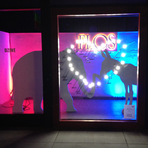
Gyöngy Laky presents a series of work examining our complex relationship with nature. Sculptural vessels are made of painted and stained branches and twigs combined with screws, nails, and wires. The organic essence of the natural wood contrasted with the spiky industrial elements draws upon the ambivalence of the natural and artificial, organic and industrial, and encapsulates co-existing feelings of violence and serenity, aggression and sanctuary.

Born in Budapest, Hungary, in 1944, Gyöngy Laky studied at UC Berkeley where she earned both her B.A. and M.A. degrees (B.A., 1970 and M.A., 1971). She has exhibited in museums and galleries throughout the United States and internationally in France, Sweden, Italy, Spain, Denmark, Holland, Switzerland, Hungary, Lithuania, Colombia, the Philippines, China, and England.
A past recipient of a National Endowment for the Arts Fellowship, and a Professor Emeritus at the University of California, Davis, Laky’s work is in museum collections in Europe and the United States, including the San Francisco MOMA, The Smithsonian’s Renwick Museum of American Art, the Philadelphia Museum of Art, the Oakland Museum, and the Contemporary Museum in Honolulu.


An artist, academic and activist (all encouraged during studies at UC Berkeley), I engage subjects of particular and on-going concern to me using hand constructions as my primary vehicle of expression. I build pieces in the architectural spectrum. Environmental concerns are obvious in my sculptures and temporary site-specific works composed of orchard, park and street tree prunings from the tons of debris available as growers and gardeners trim and dump (or burn). With these exquisite hardwoods, I play with the question, “What is waste?” What is, and is not, garbage or is considered useless, is both intriguing and problematic. The specific choices I make selecting materials and structuring forms allow me to experiment with intent and attitude, extending and altering possible responses. The juxtapositions of screws and branches or toothpicks and charcoal, address the edgy relationships and flux of human interactions with nature. With language works, incorporating words and/or signs, I borrow from the concrete poets and their visual poetry -- that physical attributes, pattern or arrangement enhances meaning. Transforming wall works and basketry into vessels for meaning lends itself to associating pieces with issues beyond just my worry about the rising threat to our environment. The word/symbol works, particularly, have allowed me to present more strongly the activist part of my life associated with such concerns as gender equity, diversity, economic upheaval and, after March of 2003, with my opposition to militarism and our wasteful and tragic wars. I support the Occupy Wall Street movement.

Below are more of Gyöngy Laky's works.

Gyöngy Laky working in her studio on her words collection piece "NO".
To check out her website go here.













-48.jpg)
-96.jpg)



-58.jpg)











